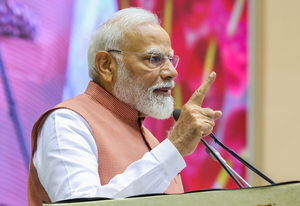Art Dubai 2024 to showcase young Indian artists
New Delhi, Feb 29 (IANS) At the 17th edition of Art Dubai at Madinat Jumeirah, Indian galleries — Emami Art and Latitude 28 — will showcase the works of young Indian artists at the Bawwaba section that is curated by Emiliano Valdes.
The Middle East’s leading international fair will be held from March 1 to March 3.
Emami Art is showcasing a solo presentation of multi-disciplinary artist Debashish Paul’s new drawings and photographs along with a sculptural costume and headdress from a recent performance at Booth W-6.
On the other hand, New-Delhi-based Latitude 28 is bringing emerging artist Manjot Kaur’s solo presentation ‘Ecosystems are Love Stories’ that weaves new myths for contemporary times by referring to historical miniature paintings of various schools at Booth W-9.
This year’s edition will feature over 100 galleries from across 40 countries within and beyond the MENASA (Middle East, North Africa and South Asia) region.
Independently or as part of his sculptural dresses, Debashish Paul’s drawings are essential to his practice. They are made from paper pasted on fabric with drawings that carry visual lexicons of his memories, self, stories and imaginations of body and intimate things.
Site-specific photography is an extended part of his practice, where he appears in sculptural dresses, signifying certain connections and elements relating to the place and theme of his performance. The body and landscape in the photographs on view, blend in, resonating with each other. Paul’s unique multi-expressionist practice is devised through dialogues with the self, society and nature.
Paul will also present a new piece — a live performance titled ‘Scent of the Celestial Garden’ — which is commissioned by Art Dubai 2024.
In Manjot Kaur’s ‘Ecosystems are Love Stories’, the artist, represented by Latitude 28, delves deep into the foundational questions concerning ecology and history.
What happens when a living tree replaces a king? What happens when trees come together to invoke a mother goddess? What happens when women take over the identity of endangered species? What happens when a heroine runs away with a tree? What happens when ecosystems decide to produce seeds?
Kaur’s works are intimate worlds encompassing the anthropology of wonder and awe, proposing narratives that imagine a multi-species future. While providing new meaning to the ancient narratives, fictionalisation and a critique of history take centre stage. This process then becomes a paradigm of change to create kinship that generates hope, love, and desperate desires for silent companionship with other species.
Shrine Empire will showcase the works of its artists Neerja Kothari and Samanta Batra Mehta. Both artists work with time and mark-making as a form of recording the sensorium of being. Samanta draws from her intergenerational experience of migration to excavate the traces of arrivals and departures that become encoded into everyday life, and the senses of (un)belonging that have been handed down through history.
Movement does not merely consist of bodies crossing oceans but the sensibilities, temporal rhythms and spatial interactions that carry with them lives left behind. Neerja’s experiences in physical rehabilitation and years of therapy to regain movement after a period of immobility due to a medical condition inform time drawings that count the everyday gestures that for her are deliberate, voluntary movements and a test of endurance.
This immediacy of bodily pain and resistance takes over from Samanta’s inherited, intergenerational experience. Samanta’s recording of the repetition of history dialogues with Neerja’s notations indicating passage of time whether morning, afternoon or night through repetitions of exercises that are restorative and depleting at the same time.
—IANS/
sukant/




